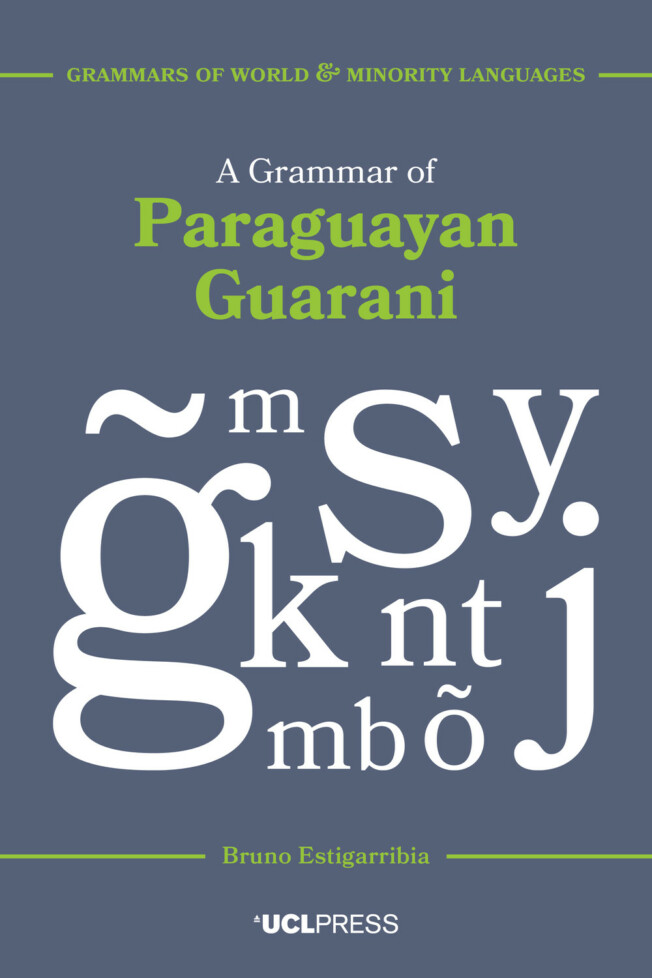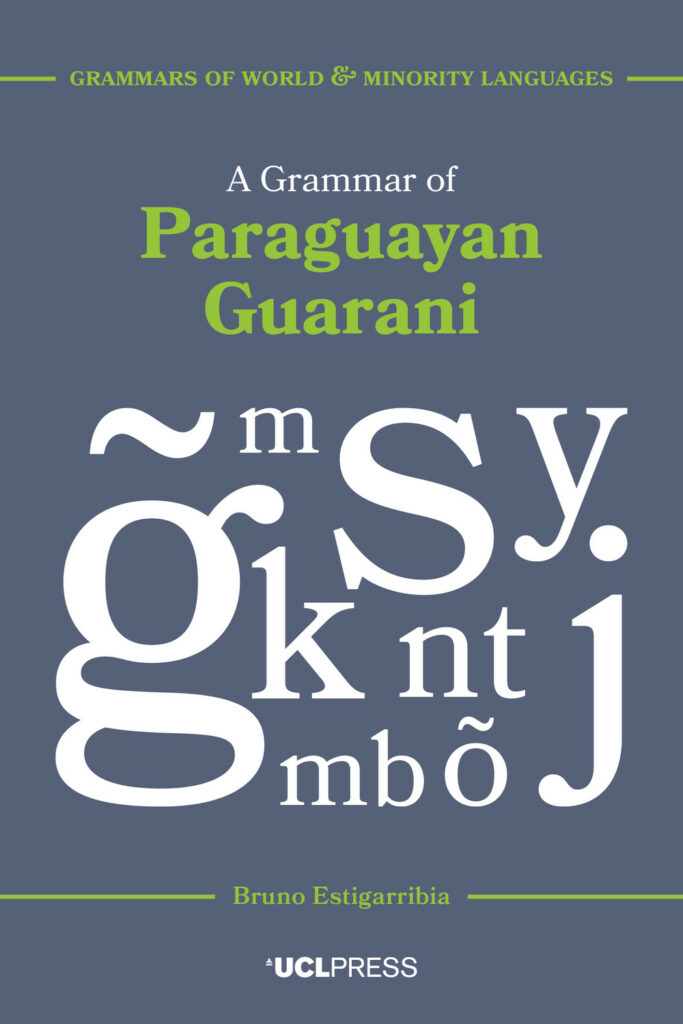
A Grammar of Paraguayan Guarani
Bruno Estigarribia (Author)
The history of Guarani is a history of resilience. Paraguayan Guarani is a vibrant, modern language, mother tongue to millions of people in South America. It is the only indigenous language in the Americas spoken by a non-ethnically indigenous majority, and since 1992, it is also an official language of Paraguay alongside Spanish. This book provides the first comprehensive reference grammar of Modern Paraguayan Guarani written for an English-language audience. It is an accessible yet thorough and carefully substantiated description of the language’s phonology, morphosyntax, and semantics. It also includes information about its centuries of documented history and its current sociolinguistic situation.
Examples come from literary sources and film, scholastic grammars, online newspapers, blogs and other publications, publicly accessible social media data, and the author’s own fieldwork. They are specifically chosen to reflect the diversity of uses of modern-day Guarani, with the aim of providing a realistic picture of the current state of the language in twenty-first century Paraguay.
This book will benefit researchers and students of Guarani and Paraguay, such as linguists, anthropologists, ethnographers, sociologists, historians, or cultural studies and literature scholars. Typologically-oriented researchers and students of other Tupian and Amerindian languages will have reliable data for comparative purposes. Given the unique socio-historical profile of Guarani, researchers in fields such as language contact, bilingualism, code-switching, language planning, language education, and literacy will find this book a valuable reference resource.
Praise for A Grammar of Paraguayan Guarani
‘innovative both in its organization and in its statements, in the conceptual apparatus chosen and in the data on which it is based’
Lingüística
‘an indispensable reference work for students and researchers from different disciplines: linguistics, anthropology, ethnography, history and whose center of interest is not only the language, but also the sociohistorical and sociolinguistic situation of the Guaraní speakers.’
RASAL – Revista de la Sociedad Argentina de Estudios Lingüísticos
- Introduction 2. Phonology and orthography: the sound system and its written representation 3. Nominals 4. Verbs 5. Postpositions 6. Voice 7. Evidentiality 8. Basic clauses 9. Quantification 10. Degree expressions 11. Noun incorporation into the verb 12. Complex sentences 13. Information structure 14. Order of affixes, clitics, and other particles in the predicate 15. Thematic glossary of highfrequency vocabulary 16. Text samples 17. Paradigms 18. Common phrases and expressions References Glossary Index
DOI: 10.14324/111.9781787352872
Number of pages: 386
Number of illustrations: 3
Publication date: 26 August 2020
PDF ISBN: 9781787352872
EPUB ISBN: 9781787353282
Hardback ISBN: 9781787353220
Paperback ISBN: 9781787352926
Bruno Estigarribia (Author) 
Bruno Estigarribia is Associate Professor of Spanish Linguistics in the Department of Romance Studies at UNC-Chapel Hill, Adjunct Faculty in the Department of Psychology and Neuroscience, and Affiliated Faculty in UNC’s Program in American Indian and Indigenous Studies and Program in Global Studies. He was born in Buenos Aires, Argentina, of a Paraguayan father and an Italian mother, and was raised in a Calabrian-speaking family. He trained as a linguist at the Université Paris V-René Descartes-Sorbonne and Stanford University.
‘innovative both in its organization and in its statements, in the conceptual apparatus chosen and in the data on which it is based’
Lingüística
‘an indispensable reference work for students and researchers from different disciplines: linguistics, anthropology, ethnography, history and whose center of interest is not only the language, but also the sociohistorical and sociolinguistic situation of the Guaraní speakers.’
RASAL – Revista de la Sociedad Argentina de Estudios Lingüísticos
Related titles
A Grammar of Paraguayan Guarani
The history of Guarani is a history of resilience. Paraguayan Guarani is a vibrant, modern language, mother tongue to millions of people in South America. It is the only indigenous language in the Americas spoken by a non-ethnically indigenous majority, and since 1992, it is also an official language of Paraguay alongside Spanish. This book provides the first comprehensive reference grammar of Modern Paraguayan Guarani written for an English-language audience. It is an accessible yet thorough and carefully substantiated description of the language’s phonology, morphosyntax, and semantics. It also includes information about its centuries of documented history and its current sociolinguistic situation.
Examples come from literary sources and film, scholastic grammars, online newspapers, blogs and other publications, publicly accessible social media data, and the author’s own fieldwork. They are specifically chosen to reflect the diversity of uses of modern-day Guarani, with the aim of providing a realistic picture of the current state of the language in twenty-first century Paraguay.
This book will benefit researchers and students of Guarani and Paraguay, such as linguists, anthropologists, ethnographers, sociologists, historians, or cultural studies and literature scholars. Typologically-oriented researchers and students of other Tupian and Amerindian languages will have reliable data for comparative purposes. Given the unique socio-historical profile of Guarani, researchers in fields such as language contact, bilingualism, code-switching, language planning, language education, and literacy will find this book a valuable reference resource.
Praise for A Grammar of Paraguayan Guarani
‘innovative both in its organization and in its statements, in the conceptual apparatus chosen and in the data on which it is based’
Lingüística
‘an indispensable reference work for students and researchers from different disciplines: linguistics, anthropology, ethnography, history and whose center of interest is not only the language, but also the sociohistorical and sociolinguistic situation of the Guaraní speakers.’
RASAL – Revista de la Sociedad Argentina de Estudios Lingüísticos
‘innovative both in its organization and in its statements, in the conceptual apparatus chosen and in the data on which it is based’
Lingüística
‘an indispensable reference work for students and researchers from different disciplines: linguistics, anthropology, ethnography, history and whose center of interest is not only the language, but also the sociohistorical and sociolinguistic situation of the Guaraní speakers.’
RASAL – Revista de la Sociedad Argentina de Estudios Lingüísticos

